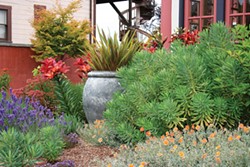[
{
"name": "Top Stories Video Pair",
"insertPoint": "7",
"component": "17087298",
"parentWrapperClass": "fdn-ads-inline-content-block",
"requiredCountToDisplay": "1"
}
]
Colorful yet refined, Mediterranean garden design seems to touch on so much of what's right in the gardening world today: an emphasis on tough, unthirsty plantings which thrive in our California climate, a nod to the importance of food and edible plants in the garden and an invitation to enjoy that Sunset-inspired indoor-outdoor lifestyle that can be so hard to achieve in the everyday bustle of life. Here's how to create your own backyard Mediterranean retreat.
Celebrate an agrarian lifestyle
Though the trend of using edibles in landscaping has been a recent one in America, this appreciation for the beauty and usefulness of herbal and edible plants has long been a part of Tuscan culture. Herbs like lavender, rosemary, sage, bay and thyme are an iconic part of a Mediterranean garden, and these evergreen plants can easily form the backbone of your garden design. Plant smaller herbs near pathways where you can brush against them and enjoy the fragrance, place lavender in loose drifts or formal lines to either soften or emphasize the lines of your home, and use larger rosemary plants to flank an entry or provide an elegant green backdrop to flowering perennials.
Though olive trees and grapevines are less successful on the coast, if you are looking for food production, Meyer lemons and fig trees can be successful in the right spot. Even if your figs don't ripen, there are recipes online for preserves made with green figs. Blueberries aren't traditional Mediterranean plants, but they do well here and go harmoniously with Tuscan plantings, given their green foliage, colorful berries, and hints of salmony orange fall that appear midway through summer.
Use a small palette of bold colors
Under the hot Tuscan sun, pale colors look washed out and unimpressive. If you are re-creating the feel of a warm Mediterranean garden, choose a simple palette of vibrant colors for a planting that will brighten even the drizzliest Humboldt morning. Since so many of the iconic Mediterranean plants bloom purple (lavender and sage come to mind), orange or apricot-colored flowers make for a perfect contrast.
Lynda Pozel, whose Eureka garden has been featured in Fine Gardening magazine, recommends choosing no more than four colors to use in the entire garden — but she suggests giving yourself license to go wild with flower shapes and styles as long as you keep within that palette. There is no reason to feel restrained to Mediterranean plants, in fact many of our California natives like monkey flower (Mimulus and Diplacus), California fuchsia (Epilobium canum), leopard lily (Lilium pardalinum) and California poppy (Eschscholzia californica) have hot colors that are an ideal fit with the Tuscan look.
Purple-flowering plants:
Lavender (Lavendula spp. and cvs.) — 'Royal Velvet,' 'Silver Anouk,' 'Twickel Purple,' and 'Phenomenal' are my recent faves.
Catmint (Nepeta faassenii) — similar color to lavender but a lower-growing, longer-blooming plant, try compact varieties like 'Little Titch' or 'Cat's Meow.'
'May Night' sage (Salvia 'May Night') — with deep purple flower spikes.
'Bergartten' sage (Salvia officianalis 'Bergartten') — a large-leaved culinary sage.
Orange or apricot-accented plants:
'Apricot Twist' wallflower (Erysimum 'Apricot Twist') — lives only a few years but is fragrant and beautiful.
Sunrose (Helianthemum nummularium) — 'Henfield Brilliant' is a shocking orange while 'Cheviot' is a light apricot.
'Fireglow' spurge (Euphorbia griffithii 'Fireglow') — with rich green leaves and fiery orange "flowers" (they're actually bracts).
'Mandarin Lights' deciduous azalea (Rhododendron 'Mandarin Lights') — good for a partially sunny spot.
Punctuate the garden with spires and vases
Italian cypress is another iconic plant in Mediterranean design that acts as a visual exclamation point within garden beds, draws the eye to doorways or defines the boundaries of the garden. The problem here in Humboldt is that Italian cypresses, including the dwarf variety 'Tiny Towers,' simply want more heat and less moisture than can be found in our cool coastal clime.
A few alternatives:
'Skyrocket' Juniper (Juniperus scopulorum 'Skyrocket')
'Emerald' arborvitae (Thuja occidentalis 'Emerald')
'Sky Pencil' Holly (Ilex crenata 'Sky Pencil')
'Graham Blandy' boxwood (Buxus sempervirens 'Graham Blandy')
As an alternative to spire-shaped plants, consider using a traditional vase-shaped pot. Similar to the jugs traditionally used to hold olive oil, these pots add another touchpoint to the agrarian history inherent in the Mediterranean style, and can be planted with flowers, turned into a bubbling water feature or just used on their own to accessorize a space.
Create generous pathways and patios
Though our homes have generous open areas and places to walk, for some reason people feel compelled to create cramped little pathways through the garden. Then we wonder why the outdoors doesn't feel inviting! If you want to feel pulled into the outdoors, keep the design of your pathways generous (5 to 8 feet would not be out of line). And if you plan to use your patio for dining, allow enough room for the table, a 2-foot buffer zone on all sides for chairs and another 2 feet around that zone so people can walk even while people are seated. This means that a patio with a 3-by-6 foot rectangular dining table would need to be at least 11-by-14 feet.
This is much larger than the average (and barely used) 4-by-8 foot patio that comes standard with many homes, and you may wonder where you'll find the space. It's simple: replace your thirsty lawn with patio, and you'll extend the square footage of your home into the backyard while lowering the maintenance needed to keep things looking good.
Use warm colors for hard surfaces
While slate, bluestone and other cool colors are beautiful in the right setting, in order to evoke the sundrenched beauty of Tuscany, you need the visual warmth from tan decomposed granite (gravel), terra-cotta colored stucco or tile, and stone or colored concrete in warm earth tones. The colors in this range tend to soften the effect of using larger pathways or patios. A large patio in a warm tan color feels much more inviting than a similar patio of gray gravel or concrete, and appears bright and cheerful even during overcast weather.
more from the author
-
Gardening Grab Bag
What's new and cool in the gardening world
- Jun 2, 2016
-
Tackling Weeds Organically
- May 5, 2016
-
The Illusion of Water in the Low-Water Garden
- Apr 7, 2016
- More »
































